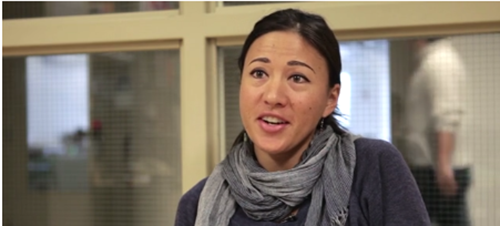Emily Pilloton | Founder and Executive Director of Project H Design

Emily Pilloton (SAIC MFA 2005) exemplifies the possibilities of forging a career path that fulfills personal passions while empowering others to reach their own self-directed potential.
Pilloton is the founder and director of Project H Design (design initiatives for Humanity, Habitats, Health, and Happiness), a nonprofit design and architecture agency she created in 2008. She operates her organization around the central idea that design can activate both education and community and capitalizes on the motivated energy of residents in the communities she engages.
“There are elements to our work and our approach that are not just involving the community but are really dependent upon the community’s vision for their own landscape,” Pilloton says. “Design is not something most people would automatically look to as a way to fix a public education system, and yet, it’s done a lot for our students and their families—and beyond the classroom walls for the community.”
The National Endowment for the Arts recently awarded Studio H, the curriculum side of the agency, a grant recognizing its work to support creative projects with a positive community impact. This high-profile acknowledgement complements Pilloton’s long-standing supporters and draws new attention to the potential for community-based design work to make a measurable impact.
At the invitation of a visionary school superintendent, Pilloton relocated to Bertie County, North Carolina in 2008, one of the most resource-poor areas in the United States. Under the structure of Project H Design, she formed a practice around socially engaged work and examines, on the ground, the systems and services of design.
Studio H, one of the agency’s core initiatives, is a high school design/build program that provides students with college credits and guides them through a yearlong process to build a full-scale project for community benefit. Projects have included chicken coops for families in need and a 2,000-square-foot farmers’ market pavilion.
Pilloton’s experience at SAIC helped prepare her for such hands-on work, and the social engagement of the Architecture, Interior Architecture, and Designed Objects program is the reason she came to the school in the first place. The self-directed yet supportive environment allowed her to guide her personal practice through the wood and metal shops and engage in conversations regarding sustainability and social issues within the field of design.
In her three years in North Carolina, Pilloton has learned that while the politics of a community can be unpredictable, design can provide a point of pride and a process through which students become invested in their hometown.
She creates a safe environment where students can fail—a liberating space in which to explore—and through trial and error, the students see their own visions come to life. “Especially in our Studio H program, the projects are really 100 percent student generated… My role as a designer is less about creating so much as facilitating these processes within a community for them to build things themselves,” Pilloton says. “It absolutely is dependent on the context and the community, and it’s really not about Project H at all. It’s not about our vision, but putting things in place so that our students can create their vision and then pull it off at full-scale,” she says.
As part of her work to continually challenge the power of design to be an increasing source of solutions, Pilloton’s 2009 book Design Revolution: 100 Products that Empower People is a collection of products that address humanitarian issues—water, food, health, and education—and was a way to create a benchmark of what had been done in this field. At the same time, she hopes the book is viewed as a helpfully critical snapshot with the caveat that there is much more we can do. “As a collection, it was an interesting way to take a barometer for what had been going on in the area of humanitarian design and hopefully an inspiration to keep working harder on constantly improving it,” she says.
For Pilloton, though, her central emphasis is an approach focused on process over product, people over objects, and finding ways to work with people instead of for them. Through her work with Studio H, she continues her commitment to design for empowerment. “Never lose sight of those things that keep you excited as a designer because they eventually one way or the other will hopefully become the things you dedicate your life to,” she says.
By Rachel Buckmaster